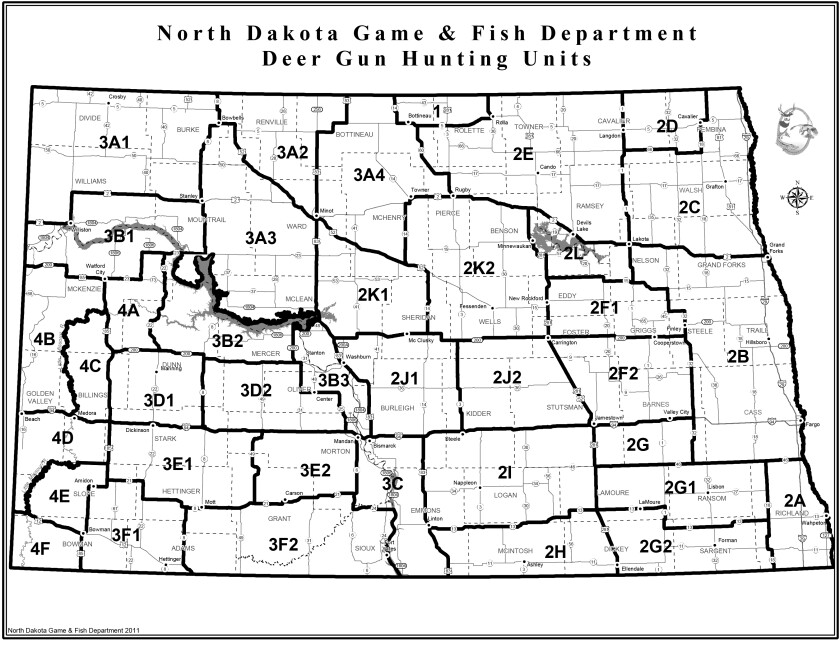GRAND FORKS -- Chronic wasting disease continues to gain a foothold in North Dakota with the news Friday, Jan. 17, that eight deer -- all bucks -- taken during the 2019 deer gun season have tested positive for the brain disease that’s fatal to deer, elk and moose.
All of the eight positives were antlered deer taken from areas previously known to have CWD -- six from unit 3F2 in south-central North Dakota and two from 3A1 in the northwest part of the state, said Charlie Bahnson, wildlife veterinarian for the North Dakota Game and Fish Department in Bismarck.
That brings the number of confirmed positive cases to about 25 since CWD first was detected in North Dakota in 2009. Six of the recent positive cases were mule deer, Bahnson said, with two whitetails from unit 3F2.

ADVERTISEMENT
Testing in North Dakota isn’t mandatory, even in CWD-positive units, and only about 15% of hunters submit deer heads for testing, Bahnson said. In that context, the actual infection rate is more meaningful than the raw number of confirmed positives, he said. Based on the sampling results, about 3% of mule deer taken in 3F2 probably were infected with CWD and about 2% in 3A1; the infection rate in whitetails in 3F2 was about 1%, he said.
“For every positive, there probably were a number of others that were never tested,” Bahnson said. “The numbers suggest the state is going in a direction we don’t want to go. We’ve got a higher infection rate and more areas than a year ago. That being said, we’re not flying off the cliff yet. It’s kind of a slow move in the wrong direction.
“I would say at this point we’re concerned, but not alarmed.”
Statewide, Game and Fish tested about 990 mule deer, 2,300 whitetails, 130 moose and about 70 elk, Bahnson said. That number included 161 mule deer and 189 whitetails in 3F2 and 307 whitetails and 156 mule deer in 3A1, Bahnson said.
Game and Fish samples CWD-positive units every fall, along with rotational surveillance in other parts of the state every few years.

In areas where CWD hasn’t been detected, only 2% to 3% of hunters actually submit deer heads for testing, Bahnson said -- about 40 deer per unit.
ADVERTISEMENT
The eight positive deer bring the total to 11 detected with CWD since Sept 1. As previously reported, two mule deer taken in September tested positive for CWD – one was killed during the archery season from deer gun unit 4B and one during the youth season in unit 3A1. CWD was also detected in a white-tailed deer from unit 3F2 that was euthanized in December after a report from the public that it appeared sick and was displaying erratic behavior.
On a positive note, none of the elk or moose sampled by Game and Fish tested positive for CWD, and eastern North Dakota remains free of the disease, as well, Bahnson said.
There is no known cure for CWD, and the disease can cause long-term population declines if left unchecked.
“Overall, we could probably live with these current infection rates long-term, but they suggest an upward trend, and we’ve certainly seen an expansion in the known distribution of the disease,” Bahnson said. “We need to continue to try to limit the spread within our herds as best as we can.”
Department staff are still in the early stages of exploring management options for responding to the increase in CWD-positive cases, Bahnson said. Game and Fish will use its 2019 surveillance data to guide its CWD management strategy going forward.
“At this point, we’re just beginning to have those conversations,” Bahnson said. “We certainly conduct the surveillance to see where we’re at and based off that, we figure out what makes the most sense moving forward. I’m reluctant to say conclusively yes or no to anything, because we’re honestly just still assessing what makes sense.”
More information about CWD can be found at the Game and Fish Department’s website, gf.nd.gov/cwd.








